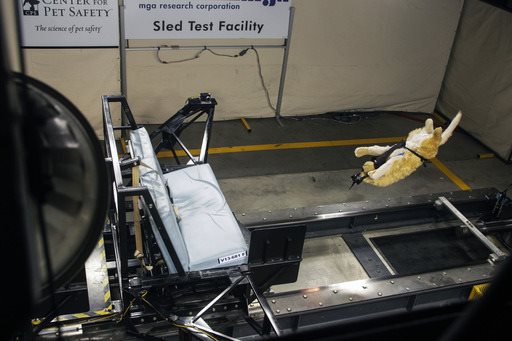(AP) Crash tests use Center for Pet Safety’s dummy dogs
By SUE MANNING
Associated Press
LOS ANGELES
To make the world safer for pets, Lindsey Wolko had to design an indestructible dog.
Two years and hundreds of thousands of dollars later, her nonprofit Center for Pet Safety in Reston, Va., has a set of crash-test dog dummies that were battered, throttled and sent flying to test several car safety restraints.
The rare study of travel products marketed to animal owners was released earlier this month and will be followed by tests of car crates, carriers and barriers. Lifejackets are on the short list of products to be tested as soon as funding is found.
Inspiration for the center and its inaugural test came nearly a decade ago.
Wolko’s dog, Maggie, was seriously injured when Wolko braked to avoid a traffic collision. Despite a restraint, the English cocker spaniel smashed into the back of the driver’s seat, spraining her spine and hip and getting her back legs tangled in the harness.
Once Maggie recovered, Wolko, an automotive engineer, started performing safety tests on her pet and other dogs. She sold products she liked on her for-profit website, caninecommuter.com.
Often, however, she found the safety equipment, toys and cleaning products were mostly untested and either failed to work as promised or fell apart.
Just as the popularity of pet products boomed, Wolko split with sales. She got her nonprofit credentials, officially opened the safety center in July 2011, met with engineers and started building a bulldog dummy.
The 55-pound bulldog is anatomically correct, stuffed with computer equipment and has the same center of gravity as the real animal. The model was used in the pilot project reviewing four products.
MGA Resource Corp., an independent lab in Manassas, Va., conducted all the crash tests using Wolko’s dog dummies.
When the pilot results were released, Subaru of America Inc. signed on to fund the rest of the study.
The final tests included a 75-pound golden retriever, 45-pound border collie and a 25-pound terrier mix.
The Sleepypod Clickit Utility Harness was the only one out of seven that protected all the dummies in 30 mph crashes.
The rest had hardware problems, construction issues, connection point failures, the stitching broke or there was catastrophic failure and the dog flew off the seat or out of the harness, she said.
Representatives from all the product manufacturers were invited to attend the testing, and four showed up, she said.
Consumer Reports magazine published the center’s results.
It’s not surprising that attention is being focused on safety because a huge number of car buyers want to drive with their pets, said Michelle Krebs, a senior analyst with Edmunds.com. “A pet that isn’t harnessed in a car is really dangerous. That animal propels through a car like a missile.”
Subaru, which markets its cars to pet owners, plans to feature the winning safety harness in a newsletter that goes out to 5 million people and to offer it for sale in its gear catalog, said Michael McHale, director of communications for the car company.
Wolko is an associate member of the Society of Automotive Engineers, with a bachelor’s degree from George Mason University. She is CEO and heads the product research division of the center, which contracts with a few part-time consultants but otherwise is run by volunteers.
___
Online
_ http://www.centerforpetsafety.org
_ http://www.subaru.com

COMMENTS
Please let us know if you're having issues with commenting.